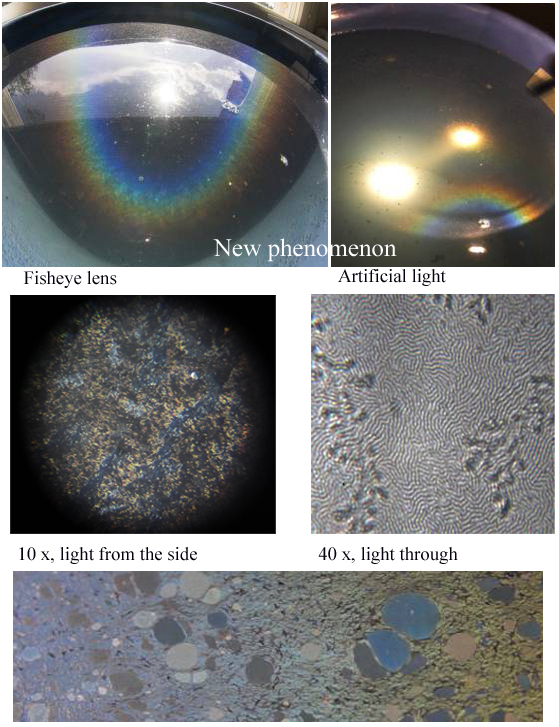 Excavating the literature finally gave confirmation that it is the alga Chromulina rosanoffii that causes Quetelet rings and glory on water surface. This unique sort of alga separates itself from the water surface by forming a stalk on top of which it rests. This is seen in the right hand microphoto which is taken parallel to the water surface. Light blue is air and black is water. On the left is a photo taken at right angle to the water surface, thus giving a look at the C. rosanoffii forest from above (transmitted light). If the alga is for some reason submerged in the water, it sheds its stalk and starts immediately swimming. The b&w photos here show C. rosanoffii submerged in water.
Excavating the literature finally gave confirmation that it is the alga Chromulina rosanoffii that causes Quetelet rings and glory on water surface. This unique sort of alga separates itself from the water surface by forming a stalk on top of which it rests. This is seen in the right hand microphoto which is taken parallel to the water surface. Light blue is air and black is water. On the left is a photo taken at right angle to the water surface, thus giving a look at the C. rosanoffii forest from above (transmitted light). If the alga is for some reason submerged in the water, it sheds its stalk and starts immediately swimming. The b&w photos here show C. rosanoffii submerged in water. Also two photos of the optical phenomena caused by this alga are displayed in the composite. On the left is a fisheye view with Quetelet rings. The glow around the camera shadow is fogbow. Notice the brightening towards nadir in fogbow, indicating possibly non-spherical particles. The photo on right is taken further away from the cultivation tub, showing spectral colored glory rings. Attached to the outmost glory ring is faint, white fogbow.
 All said here about the biology of C. rosanoffii was known long time ago. The alga was described in 1880 by Russian botanist Woronin, who encountered it while visiting Finland. One aspect of the studies carried since has been the golden glow that well developed C. rosanoffii surface film displays, as shown beside and here. But I have not yet met in the literature any mention of the spectral colors, which strikes me as a small wonder. However, there is still plenty of reading to be done, so something may come up.
All said here about the biology of C. rosanoffii was known long time ago. The alga was described in 1880 by Russian botanist Woronin, who encountered it while visiting Finland. One aspect of the studies carried since has been the golden glow that well developed C. rosanoffii surface film displays, as shown beside and here. But I have not yet met in the literature any mention of the spectral colors, which strikes me as a small wonder. However, there is still plenty of reading to be done, so something may come up.









